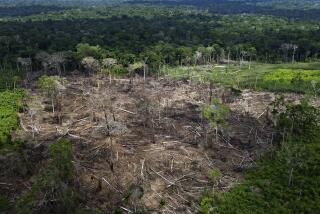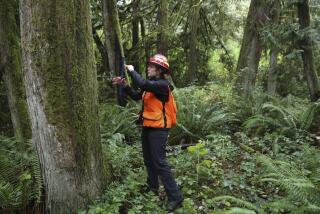Tropical Hardwoods May Be Dying Out : Environment: A researcher says older trees are being replaced by other species. He says some global process could be under way.
- Share via
WASHINGTON — Older hardwood trees are dying more rapidly than expected in tropical forests around the world and being replaced by faster-growing plants, a researcher says.
There could be some global process underway in which slower-growing trees are failing and creating gaps being filled by other trees and vines, Oliver Phillips of the Missouri Botanical Garden in St. Louis suggested Friday in the journal Science.
The result, he said, may be a change in the diversity of plants growing in tropical forests.
The process of trees dying and being replaced by other species, called the turnover rate, was measured in 40 sites that have been surveyed periodically for up to 34 years in Central and South America, West Africa, Southeast Asia and Australia.
“These are mature forests. We excluded forests that have had a large logging impact or where they had been affected by hurricane or cyclone or drought,” Phillips said. “This suggests there is some sort of global factor.”
Phillips said an accelerating turnover rate may be associated with an increase of carbon dioxide in the atmosphere, which would tend to favor faster-growing species. He said atmospheric carbon dioxide, mostly from burning of fossil fuels, has increased 10% to 15% globally since the 1950s. Carbon dioxide is a key chemical in the process of photosynthesis used by plants to grow.
Not everyone agrees with his views.
John Terborgh of the Duke University Center of Tropical Conservation in Durham, N.C., said he believes Phillips’ conclusions are “highly speculative.”
“The reported rate of turnover is much faster and far greater than the increase in carbon dioxide over the same period,” Terborgh said. “His evidence is extremely indirect.”
Terborgh said Phillips’ conclusions also could be flawed because of the way in which the surveyed sites were selected. He said they were chosen by other researchers over the years and that botanists tend to select sites that fit particular characteristics that may not be representative of global tropical forests.
“The fact that the turnover rate seems to be increasing may be an illusion,” Terborgh said.
Phillips said that older hardwood trees that grow slowly in shade are dying and falling, leaving gaps in forest canopies and admitting sunlight. The gaps are then filled by faster-growing trees and vines. His study indicates that this process is increasing.
“If the forest turnover rates continue to increase, primary forests may become more characterized by climbing plants and gap-dependent tree species,” he said in the study.
Science, which published the study, is the journal of the American Assn. for the Advancement of Science.
More to Read
Sign up for Essential California
The most important California stories and recommendations in your inbox every morning.
You may occasionally receive promotional content from the Los Angeles Times.












